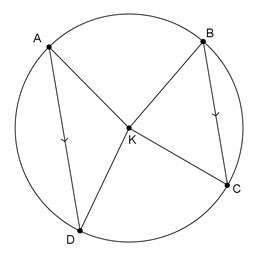Now you will investigate and prove some conjectures about chords in a circle. Suppose you have a circle containing 2 parallel chords.
![]() Click on the "Begin Animation" button below and look for relationships. What do you notice about the intercepted arcs?
Click on the "Begin Animation" button below and look for relationships. What do you notice about the intercepted arcs?
Copy the following in your notes, filling in the blanks. Click on the blanks to reveal the answers.
The measure of the first arc is Interactive button. Assistance may be required. _________ 50° and the measure of the second arc is Interactive button. Assistance may be required. _________ 50° .
Conjecture: If a circle contains parallel chords, those chords intercept Interactive button. Assistance may be required. _________ congruent arcs.
Now let's prove the conjecture.
![]() Complete the following drag and drop puzzle to prove that this conjecture is true. Use the pictures to help you organize the statements and reasons in your proof. Use the Reset button to reset the puzzle if necessary.
Complete the following drag and drop puzzle to prove that this conjecture is true. Use the pictures to help you organize the statements and reasons in your proof. Use the Reset button to reset the puzzle if necessary.
Use circle K with parallel chords AD and BC, shown below, to answer questions 1-3.

 = 83°, what is m
= 83°, what is m ? How do you know?
? How do you know?
Interactive popup. Assistance may be required.
How are and
and  related to the two parallel chords?
related to the two parallel chords?

Interactive popup. Assistance may be required.
m = 83° because two arcs intercepted by parallel chords are congruent, and congruent arcs have equal measures.
= 83° because two arcs intercepted by parallel chords are congruent, and congruent arcs have equal measures. 
 ≅
≅ 
Interactive popup. Assistance may be required.
Which two arcs are intercepted by parallel chords?
Interactive popup. Assistance may be required.
Conjectures II and IV only
 ? How do you know?
? How do you know?
Interactive popup. Assistance may be required.
How does m∠AKB relate to its intercepted arc?
Interactive popup. Assistance may be required.
m = 78.5°. ∠AKB is a central angle that intercepts
= 78.5°. ∠AKB is a central angle that intercepts  , so m
, so m = m∠AKB = 78.5° because a central angle has an angle measure that is equal to the measure of the intercepted arc.
= m∠AKB = 78.5° because a central angle has an angle measure that is equal to the measure of the intercepted arc.  ≅
≅  because they are intercepted arcs of parallel chords. m
because they are intercepted arcs of parallel chords. m = m
= m because congruent arcs have equal measures, so m
because congruent arcs have equal measures, so m = 78.5°.
= 78.5°. 